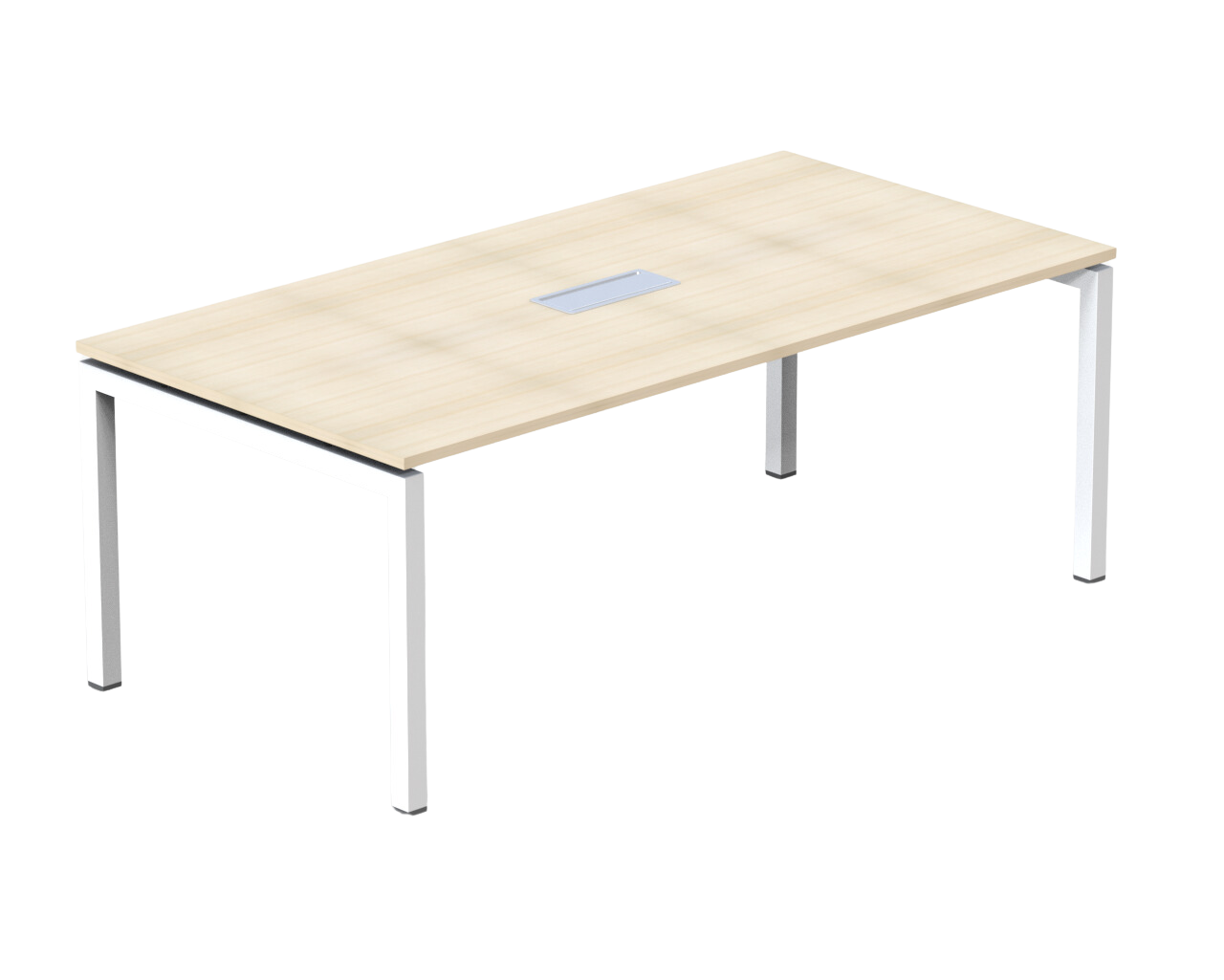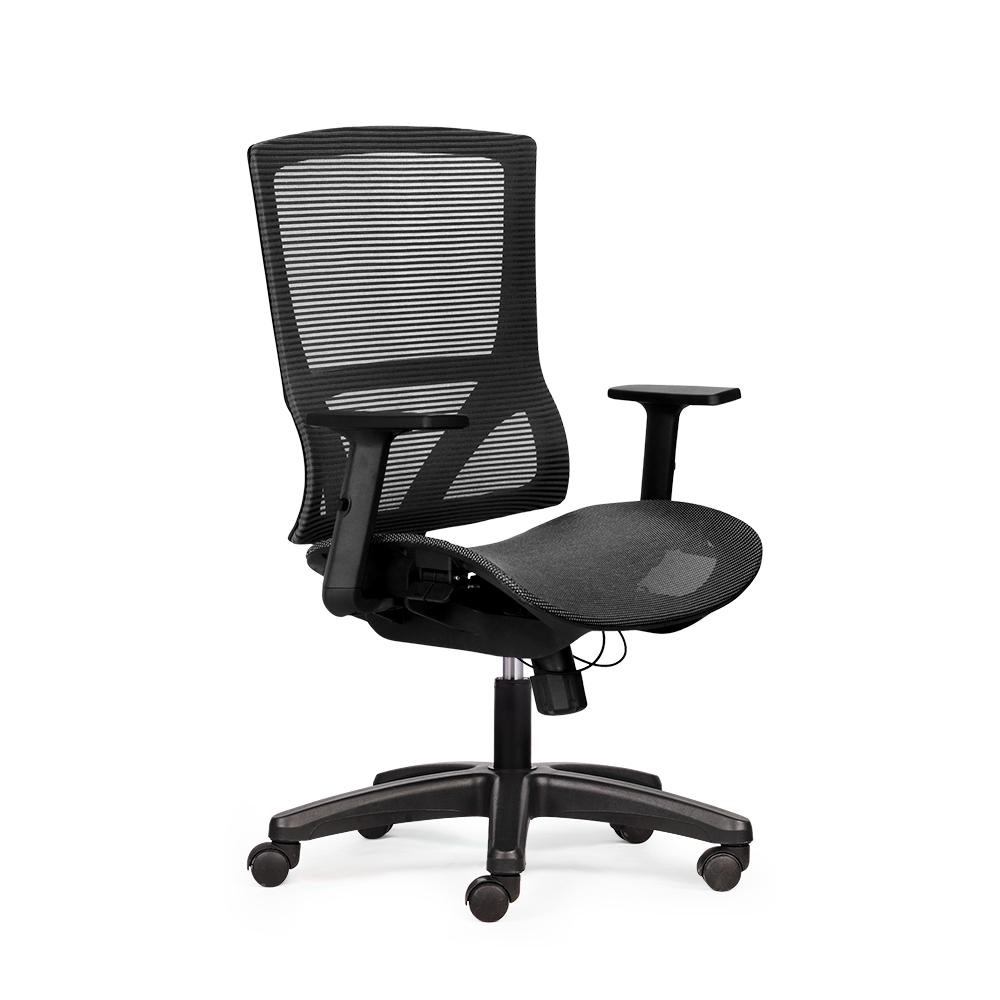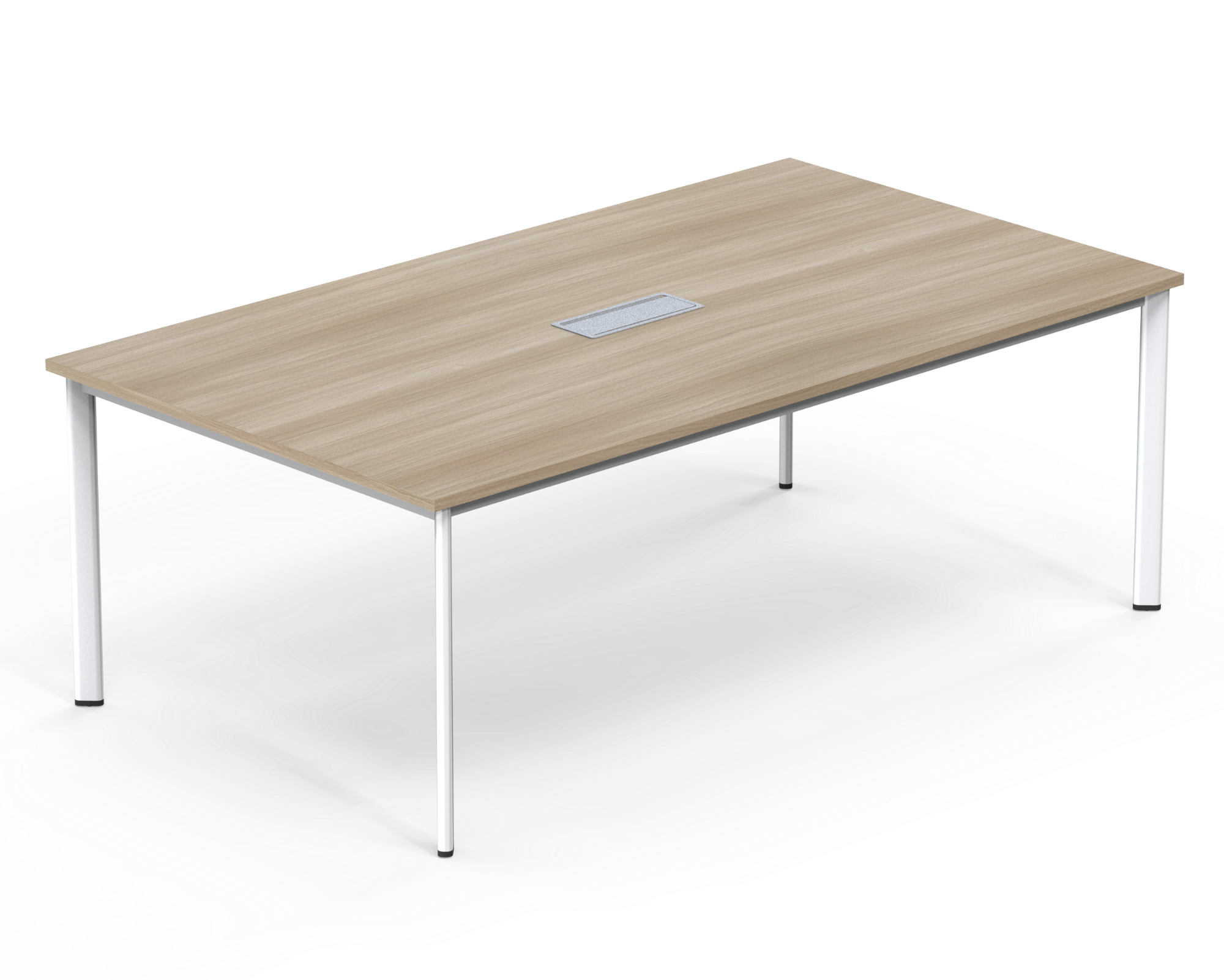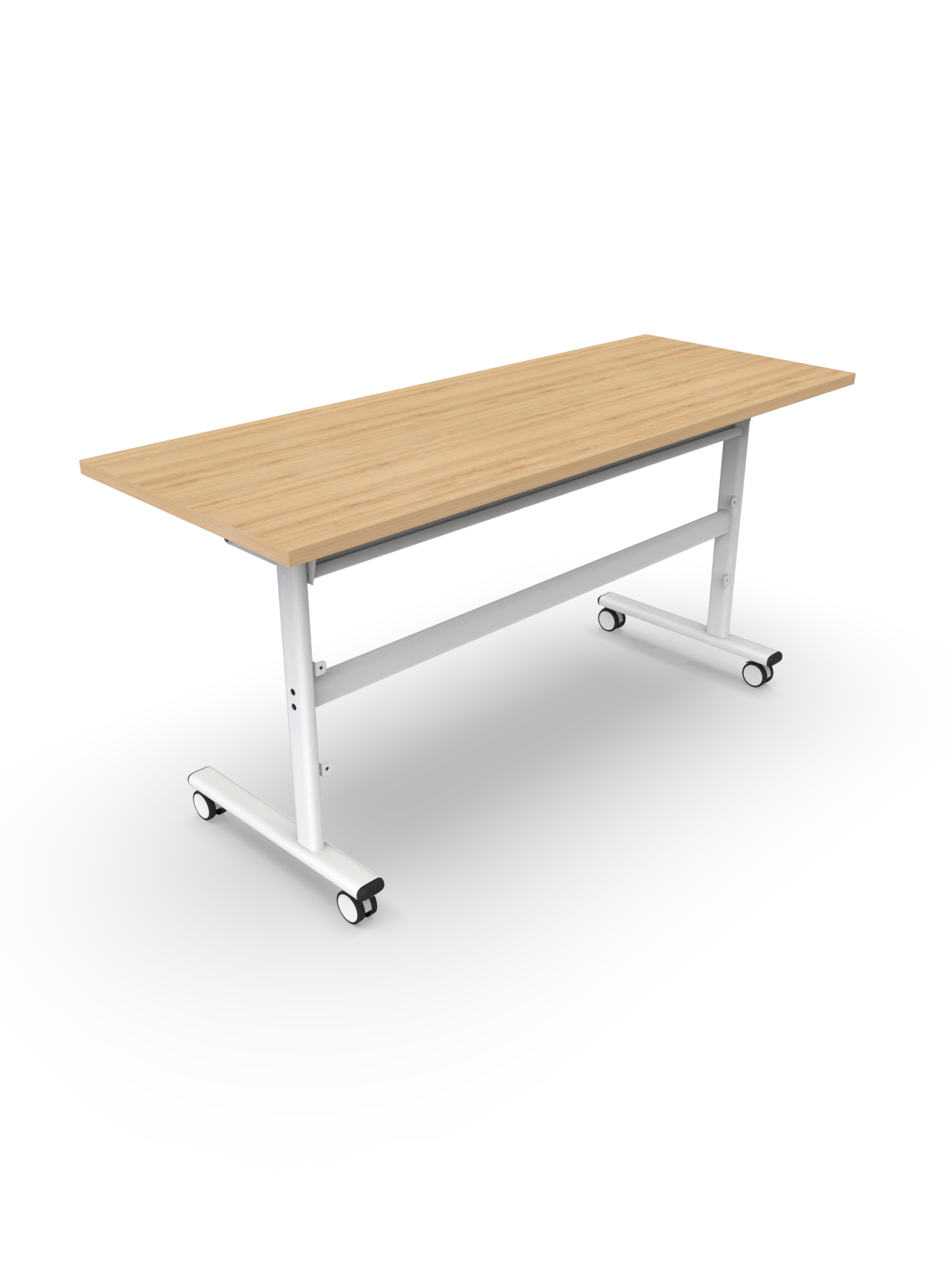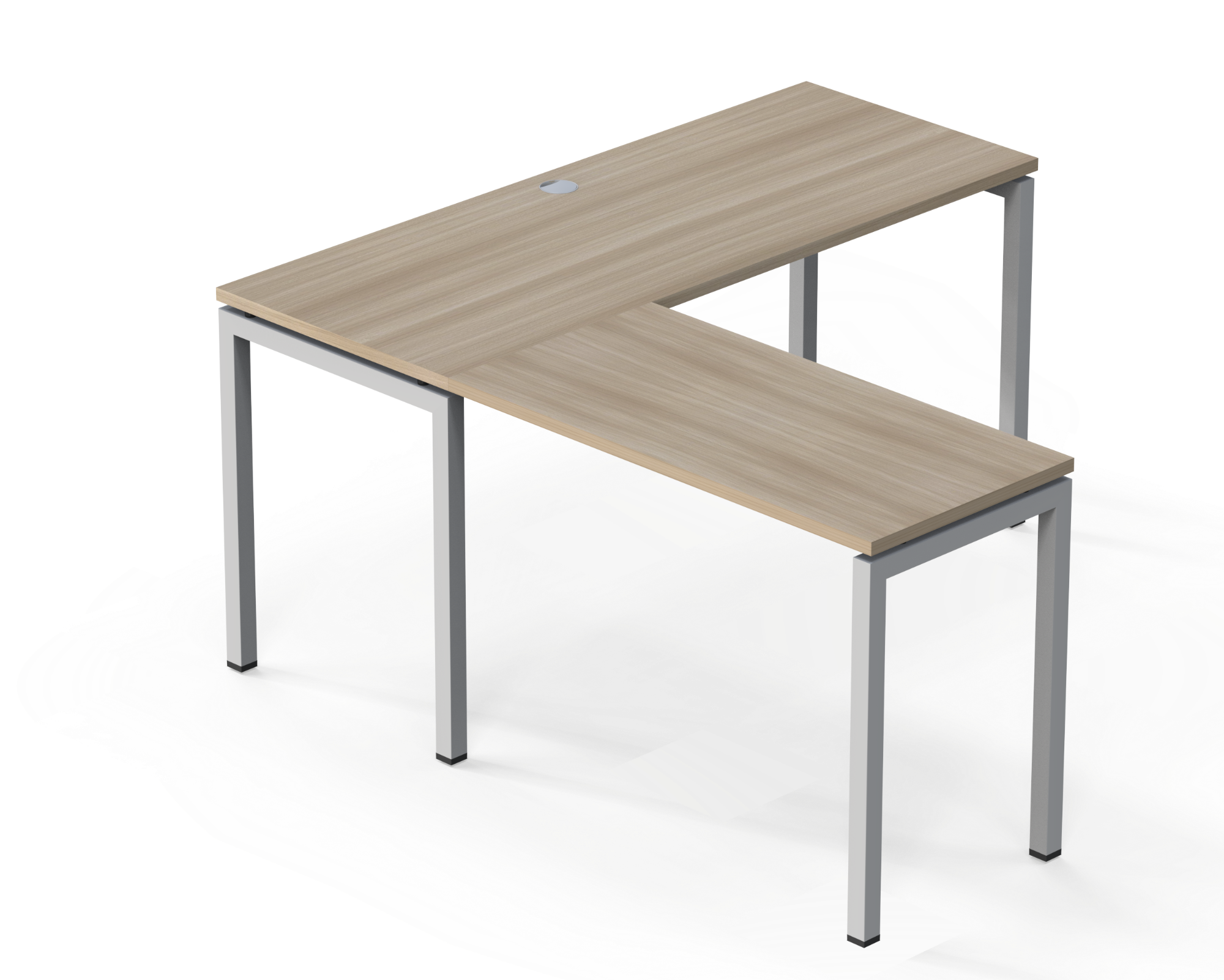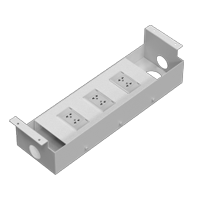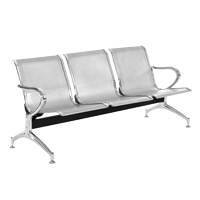
Choosing the right meeting table based on room size and scale
Meeting rooms are always among the most important spaces in any business. They are not only the venue for daily discussions, but also the place where strategic ideas are exchanged, contracts are signed, and partners are welcomed. Therefore, selecting a meeting table that fits the size and scale of the meeting room is not merely a practical decision, but also a factor that reflects a company’s brand image. A thoughtfully chosen meeting table can bring a sense of professionalism, modernity, and harmony to the office space. On the other hand, an inappropriate choice can make the room feel cramped, cause discomfort during use, and leave a negative impression on clients and partners. Especially for SMEs, startups, or growing businesses, the meeting room often serves as the “face” of the company, showcasing its stature and professionalism to visitors. For this reason, choosing the right meeting table requires careful consideration, planning, and often professional consultation.
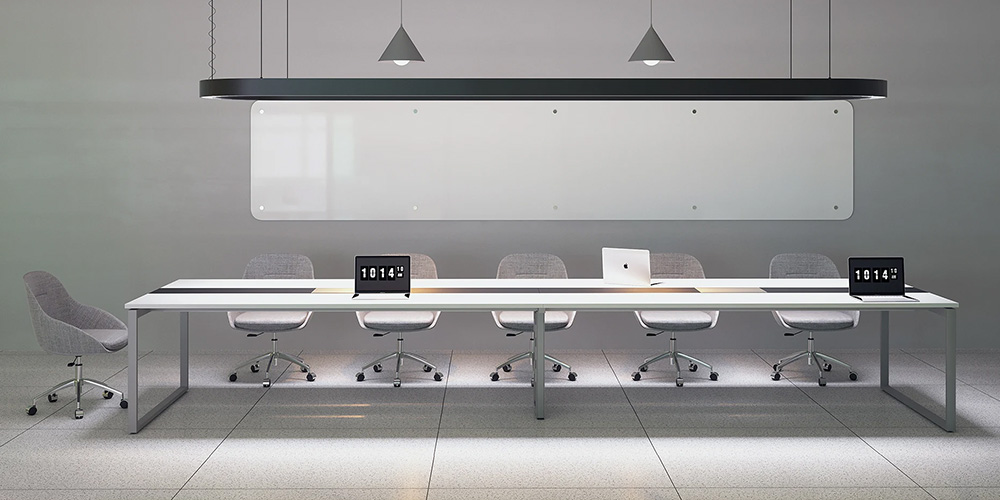
1. Why is it important to choose a meeting table that suits the room size and scale?
1.1 Optimizing functionality
A meeting table with the right dimensions ensures participants have enough personal space, can move comfortably, and engage in discussions with ease. If the table is too small, employees may feel cramped and struggle with documents or personal devices. On the contrary, an oversized table in a small room can make the space feel suffocating, restricting airflow and natural light. Moreover, a well-arranged meeting room improves circulation, which is especially important in large gatherings or when hosting partners. A functional and comfortable setting contributes directly to meeting productivity and decision-making quality.
1.2 Enhancing aesthetics and harmony
A meeting table proportionate to the room’s size enhances the overall spaciousness and professional look of the environment. Interior design is not just about arranging furniture but also balancing shapes, colors, and lighting. A properly sized table helps maintain visual harmony, keeping participants focused. If the table is either too large or too small, the room may appear unbalanced and less appealing. For companies that frequently host partners or conduct high-level conferences, the meeting table becomes the centerpiece that reinforces a professional brand image.
1.3 Saving costs in the long run
Choosing the right table size, style, and material from the beginning saves businesses significant costs. An ill-suited table may need to be replaced after only a few months, wasting money and effort on removal and reinstallation. In large office projects, selecting the right table also helps optimize space usage, reducing rental costs and avoiding the need for costly restructuring later. A durable, high-quality table further lowers maintenance expenses, making the initial investment a financially smart move.
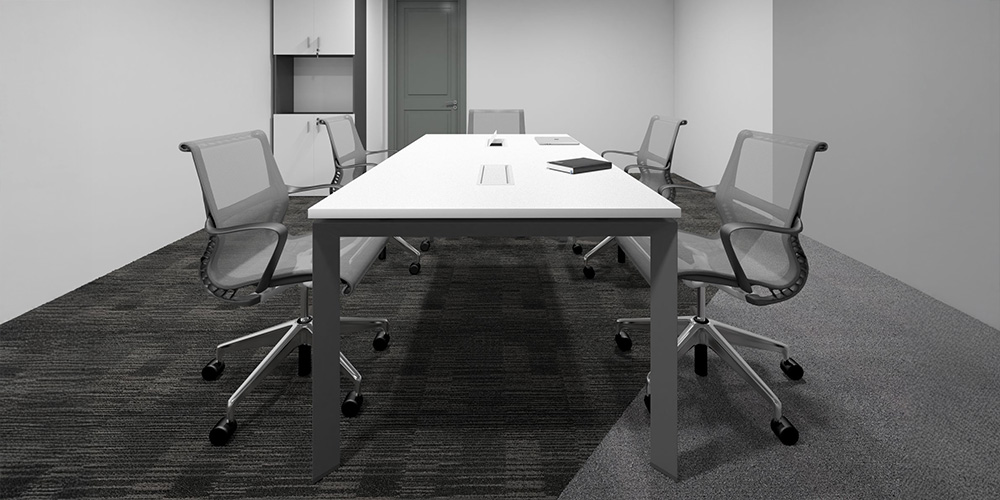
2. Popular meeting table options by room size
2.1 Small meeting rooms (<15m², 4–6 people)
For compact meeting rooms, round or oval tables are ideal. These shapes maximize space while creating a sense of friendliness and equality among participants. Round tables, in particular, encourage open discussion and reduce hierarchical barriers, making them suitable for young, dynamic businesses. Tables with steel legs and wooden tops in sizes from 1.2m to 1.6m are commonly used in small spaces, offering modernity without clutter. Startups, tech firms, and creative agencies often choose these models to maintain flexibility in their work environments.
2.2 Medium meeting rooms (15–30m², 8–12 people)
Medium-sized meeting rooms typically work best with rectangular tables ranging from 2m to 2.4m in length. This is the most common style due to its practicality and compatibility with most office setups. A 2.4m steel-leg rectangular table offers a modern look and pairs well with ergonomic chairs, storage cabinets, and AV equipment. The rectangular shape also clearly defines seating positions, especially for executives, making it suitable for decision-making sessions. Alternatively, oval tables can also be used to soften the atmosphere while maintaining formality.
2.3 Large meeting rooms (>30m², 14–20 people)
For spacious meeting rooms, particularly in businesses with 50 or more employees, elliptical or U-shaped tables are ideal. These designs allow everyone to maintain visual contact, making them effective for group discussions and presentations. High-end materials such as stone tops or premium veneer are often chosen to convey elegance and prestige. This type of setup is common in boardrooms, executive meeting spaces, and companies hosting international clients. A large, luxurious table not only accommodates more people but also reinforces the brand’s authority and reputation.
3. Key criteria for selecting the right meeting table
3.1 Proper dimensions for the room
The general rule is that there should be at least 1 meter of clearance between the table and the walls or other furniture, ensuring easy movement. Without this clearance, participants may struggle to enter, exit, or move during meetings. For rooms equipped with projectors or screens, placement and sightlines must also be considered. A table with the right proportions enhances both comfort and visual balance, supporting smooth operations.
3.2 Material and durability
The material of the meeting table determines not only its lifespan but also the tone of the space. Steel-leg wooden tables are popular for their durability, lightweight structure, and ease of relocation—perfect for modern offices. Veneer or stone tables, on the other hand, bring luxury and authority, fitting for executive spaces. Sustainability is also a rising priority, with many companies opting for eco-friendly engineered wood (E1 standard), moisture-resistant veneer, or safe synthetic stone. These options ensure durability while aligning with long-term sustainable goals.
3.3 Design that matches the office style
The design of the meeting table should be consistent with the office’s overall interior concept. For example, a minimalist office pairs well with neutral-toned steel-leg tables, while a luxury-oriented office benefits from polished veneer or natural stone patterns. It’s also important to coordinate with chairs, storage units, and decorative details to maintain cohesion. When the table complements the space, the meeting room becomes a focal point that enhances user experience and brand perception.
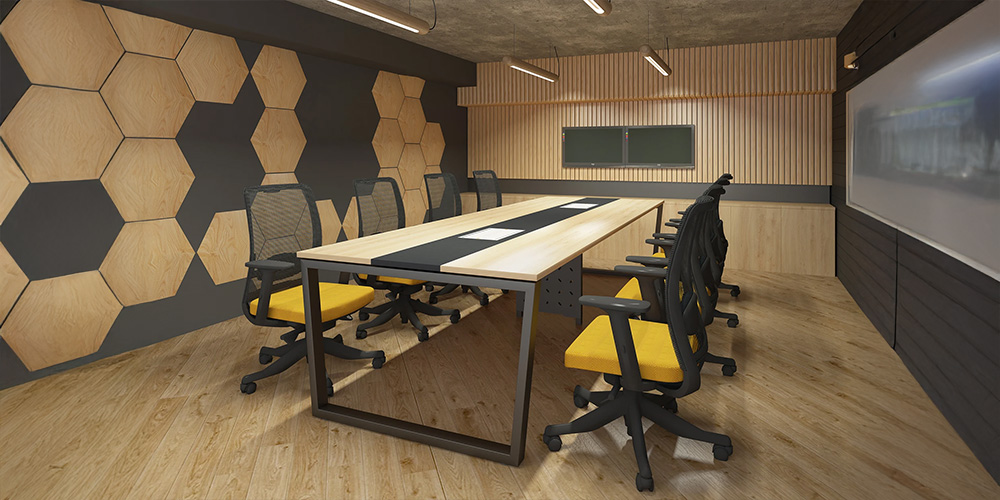
4. Benefits of choosing meeting tables from The Mia
By selecting The Mia’s meeting tables, businesses gain a range of advantages. First, The Mia offers a wide variety of sizes and materials to suit different needs—from compact startup offices to large corporate headquarters. Customers also benefit from free design consultation, including 3D visualizations that demonstrate how the table integrates with their existing layout. The Mia ensures fast delivery and professional installation, which is especially valuable for time-sensitive projects.
Quality is another strong point: all products are manufactured to BIFMA standards using imported materials, ensuring durability, safety, and comfort. Moreover, The Mia provides long-term warranty and after-sales services, accompanying businesses throughout the product lifecycle. This dedication and professionalism have made The Mia a trusted choice for office furniture in Vietnam, helping companies build both functionality and prestige into their meeting spaces.
Other news
1.1 Optimizing functionality
A meeting table with the right dimensions ensures participants have enough personal space, can move comfortably, and engage in discussions with ease. If the table is too small, employees may feel cramped and struggle with documents or personal devices. On the contrary, an oversized table in a small room can make the space feel suffocating, restricting airflow and natural light. Moreover, a well-arranged meeting room improves circulation, which is especially important in large gatherings or when hosting partners. A functional and comfortable setting contributes directly to meeting productivity and decision-making quality.
1.2 Enhancing aesthetics and harmony
A meeting table proportionate to the room’s size enhances the overall spaciousness and professional look of the environment. Interior design is not just about arranging furniture but also balancing shapes, colors, and lighting. A properly sized table helps maintain visual harmony, keeping participants focused. If the table is either too large or too small, the room may appear unbalanced and less appealing. For companies that frequently host partners or conduct high-level conferences, the meeting table becomes the centerpiece that reinforces a professional brand image.
1.3 Saving costs in the long run
Choosing the right table size, style, and material from the beginning saves businesses significant costs. An ill-suited table may need to be replaced after only a few months, wasting money and effort on removal and reinstallation. In large office projects, selecting the right table also helps optimize space usage, reducing rental costs and avoiding the need for costly restructuring later. A durable, high-quality table further lowers maintenance expenses, making the initial investment a financially smart move.

2. Popular meeting table options by room size
2.1 Small meeting rooms (<15m², 4–6 people)
For compact meeting rooms, round or oval tables are ideal. These shapes maximize space while creating a sense of friendliness and equality among participants. Round tables, in particular, encourage open discussion and reduce hierarchical barriers, making them suitable for young, dynamic businesses. Tables with steel legs and wooden tops in sizes from 1.2m to 1.6m are commonly used in small spaces, offering modernity without clutter. Startups, tech firms, and creative agencies often choose these models to maintain flexibility in their work environments.
2.2 Medium meeting rooms (15–30m², 8–12 people)
Medium-sized meeting rooms typically work best with rectangular tables ranging from 2m to 2.4m in length. This is the most common style due to its practicality and compatibility with most office setups. A 2.4m steel-leg rectangular table offers a modern look and pairs well with ergonomic chairs, storage cabinets, and AV equipment. The rectangular shape also clearly defines seating positions, especially for executives, making it suitable for decision-making sessions. Alternatively, oval tables can also be used to soften the atmosphere while maintaining formality.
2.3 Large meeting rooms (>30m², 14–20 people)
For spacious meeting rooms, particularly in businesses with 50 or more employees, elliptical or U-shaped tables are ideal. These designs allow everyone to maintain visual contact, making them effective for group discussions and presentations. High-end materials such as stone tops or premium veneer are often chosen to convey elegance and prestige. This type of setup is common in boardrooms, executive meeting spaces, and companies hosting international clients. A large, luxurious table not only accommodates more people but also reinforces the brand’s authority and reputation.
3. Key criteria for selecting the right meeting table
3.1 Proper dimensions for the room
The general rule is that there should be at least 1 meter of clearance between the table and the walls or other furniture, ensuring easy movement. Without this clearance, participants may struggle to enter, exit, or move during meetings. For rooms equipped with projectors or screens, placement and sightlines must also be considered. A table with the right proportions enhances both comfort and visual balance, supporting smooth operations.
3.2 Material and durability
The material of the meeting table determines not only its lifespan but also the tone of the space. Steel-leg wooden tables are popular for their durability, lightweight structure, and ease of relocation—perfect for modern offices. Veneer or stone tables, on the other hand, bring luxury and authority, fitting for executive spaces. Sustainability is also a rising priority, with many companies opting for eco-friendly engineered wood (E1 standard), moisture-resistant veneer, or safe synthetic stone. These options ensure durability while aligning with long-term sustainable goals.
3.3 Design that matches the office style
The design of the meeting table should be consistent with the office’s overall interior concept. For example, a minimalist office pairs well with neutral-toned steel-leg tables, while a luxury-oriented office benefits from polished veneer or natural stone patterns. It’s also important to coordinate with chairs, storage units, and decorative details to maintain cohesion. When the table complements the space, the meeting room becomes a focal point that enhances user experience and brand perception.

4. Benefits of choosing meeting tables from The Mia
By selecting The Mia’s meeting tables, businesses gain a range of advantages. First, The Mia offers a wide variety of sizes and materials to suit different needs—from compact startup offices to large corporate headquarters. Customers also benefit from free design consultation, including 3D visualizations that demonstrate how the table integrates with their existing layout. The Mia ensures fast delivery and professional installation, which is especially valuable for time-sensitive projects.
Quality is another strong point: all products are manufactured to BIFMA standards using imported materials, ensuring durability, safety, and comfort. Moreover, The Mia provides long-term warranty and after-sales services, accompanying businesses throughout the product lifecycle. This dedication and professionalism have made The Mia a trusted choice for office furniture in Vietnam, helping companies build both functionality and prestige into their meeting spaces.
Other news
A meeting table with the right dimensions ensures participants have enough personal space, can move comfortably, and engage in discussions with ease. If the table is too small, employees may feel cramped and struggle with documents or personal devices. On the contrary, an oversized table in a small room can make the space feel suffocating, restricting airflow and natural light. Moreover, a well-arranged meeting room improves circulation, which is especially important in large gatherings or when hosting partners. A functional and comfortable setting contributes directly to meeting productivity and decision-making quality.
1.2 Enhancing aesthetics and harmony
A meeting table proportionate to the room’s size enhances the overall spaciousness and professional look of the environment. Interior design is not just about arranging furniture but also balancing shapes, colors, and lighting. A properly sized table helps maintain visual harmony, keeping participants focused. If the table is either too large or too small, the room may appear unbalanced and less appealing. For companies that frequently host partners or conduct high-level conferences, the meeting table becomes the centerpiece that reinforces a professional brand image.
1.3 Saving costs in the long run
Choosing the right table size, style, and material from the beginning saves businesses significant costs. An ill-suited table may need to be replaced after only a few months, wasting money and effort on removal and reinstallation. In large office projects, selecting the right table also helps optimize space usage, reducing rental costs and avoiding the need for costly restructuring later. A durable, high-quality table further lowers maintenance expenses, making the initial investment a financially smart move.

2. Popular meeting table options by room size
2.1 Small meeting rooms (<15m², 4–6 people)
For compact meeting rooms, round or oval tables are ideal. These shapes maximize space while creating a sense of friendliness and equality among participants. Round tables, in particular, encourage open discussion and reduce hierarchical barriers, making them suitable for young, dynamic businesses. Tables with steel legs and wooden tops in sizes from 1.2m to 1.6m are commonly used in small spaces, offering modernity without clutter. Startups, tech firms, and creative agencies often choose these models to maintain flexibility in their work environments.
2.2 Medium meeting rooms (15–30m², 8–12 people)
Medium-sized meeting rooms typically work best with rectangular tables ranging from 2m to 2.4m in length. This is the most common style due to its practicality and compatibility with most office setups. A 2.4m steel-leg rectangular table offers a modern look and pairs well with ergonomic chairs, storage cabinets, and AV equipment. The rectangular shape also clearly defines seating positions, especially for executives, making it suitable for decision-making sessions. Alternatively, oval tables can also be used to soften the atmosphere while maintaining formality.
2.3 Large meeting rooms (>30m², 14–20 people)
For spacious meeting rooms, particularly in businesses with 50 or more employees, elliptical or U-shaped tables are ideal. These designs allow everyone to maintain visual contact, making them effective for group discussions and presentations. High-end materials such as stone tops or premium veneer are often chosen to convey elegance and prestige. This type of setup is common in boardrooms, executive meeting spaces, and companies hosting international clients. A large, luxurious table not only accommodates more people but also reinforces the brand’s authority and reputation.
3. Key criteria for selecting the right meeting table
3.1 Proper dimensions for the room
The general rule is that there should be at least 1 meter of clearance between the table and the walls or other furniture, ensuring easy movement. Without this clearance, participants may struggle to enter, exit, or move during meetings. For rooms equipped with projectors or screens, placement and sightlines must also be considered. A table with the right proportions enhances both comfort and visual balance, supporting smooth operations.
3.2 Material and durability
The material of the meeting table determines not only its lifespan but also the tone of the space. Steel-leg wooden tables are popular for their durability, lightweight structure, and ease of relocation—perfect for modern offices. Veneer or stone tables, on the other hand, bring luxury and authority, fitting for executive spaces. Sustainability is also a rising priority, with many companies opting for eco-friendly engineered wood (E1 standard), moisture-resistant veneer, or safe synthetic stone. These options ensure durability while aligning with long-term sustainable goals.
3.3 Design that matches the office style
The design of the meeting table should be consistent with the office’s overall interior concept. For example, a minimalist office pairs well with neutral-toned steel-leg tables, while a luxury-oriented office benefits from polished veneer or natural stone patterns. It’s also important to coordinate with chairs, storage units, and decorative details to maintain cohesion. When the table complements the space, the meeting room becomes a focal point that enhances user experience and brand perception.

4. Benefits of choosing meeting tables from The Mia
By selecting The Mia’s meeting tables, businesses gain a range of advantages. First, The Mia offers a wide variety of sizes and materials to suit different needs—from compact startup offices to large corporate headquarters. Customers also benefit from free design consultation, including 3D visualizations that demonstrate how the table integrates with their existing layout. The Mia ensures fast delivery and professional installation, which is especially valuable for time-sensitive projects.
Quality is another strong point: all products are manufactured to BIFMA standards using imported materials, ensuring durability, safety, and comfort. Moreover, The Mia provides long-term warranty and after-sales services, accompanying businesses throughout the product lifecycle. This dedication and professionalism have made The Mia a trusted choice for office furniture in Vietnam, helping companies build both functionality and prestige into their meeting spaces.
Other news
A meeting table proportionate to the room’s size enhances the overall spaciousness and professional look of the environment. Interior design is not just about arranging furniture but also balancing shapes, colors, and lighting. A properly sized table helps maintain visual harmony, keeping participants focused. If the table is either too large or too small, the room may appear unbalanced and less appealing. For companies that frequently host partners or conduct high-level conferences, the meeting table becomes the centerpiece that reinforces a professional brand image.
1.3 Saving costs in the long run
Choosing the right table size, style, and material from the beginning saves businesses significant costs. An ill-suited table may need to be replaced after only a few months, wasting money and effort on removal and reinstallation. In large office projects, selecting the right table also helps optimize space usage, reducing rental costs and avoiding the need for costly restructuring later. A durable, high-quality table further lowers maintenance expenses, making the initial investment a financially smart move.

2. Popular meeting table options by room size
2.1 Small meeting rooms (<15m², 4–6 people)
For compact meeting rooms, round or oval tables are ideal. These shapes maximize space while creating a sense of friendliness and equality among participants. Round tables, in particular, encourage open discussion and reduce hierarchical barriers, making them suitable for young, dynamic businesses. Tables with steel legs and wooden tops in sizes from 1.2m to 1.6m are commonly used in small spaces, offering modernity without clutter. Startups, tech firms, and creative agencies often choose these models to maintain flexibility in their work environments.
2.2 Medium meeting rooms (15–30m², 8–12 people)
Medium-sized meeting rooms typically work best with rectangular tables ranging from 2m to 2.4m in length. This is the most common style due to its practicality and compatibility with most office setups. A 2.4m steel-leg rectangular table offers a modern look and pairs well with ergonomic chairs, storage cabinets, and AV equipment. The rectangular shape also clearly defines seating positions, especially for executives, making it suitable for decision-making sessions. Alternatively, oval tables can also be used to soften the atmosphere while maintaining formality.
2.3 Large meeting rooms (>30m², 14–20 people)
For spacious meeting rooms, particularly in businesses with 50 or more employees, elliptical or U-shaped tables are ideal. These designs allow everyone to maintain visual contact, making them effective for group discussions and presentations. High-end materials such as stone tops or premium veneer are often chosen to convey elegance and prestige. This type of setup is common in boardrooms, executive meeting spaces, and companies hosting international clients. A large, luxurious table not only accommodates more people but also reinforces the brand’s authority and reputation.
3. Key criteria for selecting the right meeting table
3.1 Proper dimensions for the room
The general rule is that there should be at least 1 meter of clearance between the table and the walls or other furniture, ensuring easy movement. Without this clearance, participants may struggle to enter, exit, or move during meetings. For rooms equipped with projectors or screens, placement and sightlines must also be considered. A table with the right proportions enhances both comfort and visual balance, supporting smooth operations.
3.2 Material and durability
The material of the meeting table determines not only its lifespan but also the tone of the space. Steel-leg wooden tables are popular for their durability, lightweight structure, and ease of relocation—perfect for modern offices. Veneer or stone tables, on the other hand, bring luxury and authority, fitting for executive spaces. Sustainability is also a rising priority, with many companies opting for eco-friendly engineered wood (E1 standard), moisture-resistant veneer, or safe synthetic stone. These options ensure durability while aligning with long-term sustainable goals.
3.3 Design that matches the office style
The design of the meeting table should be consistent with the office’s overall interior concept. For example, a minimalist office pairs well with neutral-toned steel-leg tables, while a luxury-oriented office benefits from polished veneer or natural stone patterns. It’s also important to coordinate with chairs, storage units, and decorative details to maintain cohesion. When the table complements the space, the meeting room becomes a focal point that enhances user experience and brand perception.

4. Benefits of choosing meeting tables from The Mia
By selecting The Mia’s meeting tables, businesses gain a range of advantages. First, The Mia offers a wide variety of sizes and materials to suit different needs—from compact startup offices to large corporate headquarters. Customers also benefit from free design consultation, including 3D visualizations that demonstrate how the table integrates with their existing layout. The Mia ensures fast delivery and professional installation, which is especially valuable for time-sensitive projects.
Quality is another strong point: all products are manufactured to BIFMA standards using imported materials, ensuring durability, safety, and comfort. Moreover, The Mia provides long-term warranty and after-sales services, accompanying businesses throughout the product lifecycle. This dedication and professionalism have made The Mia a trusted choice for office furniture in Vietnam, helping companies build both functionality and prestige into their meeting spaces.
Other news
Choosing the right table size, style, and material from the beginning saves businesses significant costs. An ill-suited table may need to be replaced after only a few months, wasting money and effort on removal and reinstallation. In large office projects, selecting the right table also helps optimize space usage, reducing rental costs and avoiding the need for costly restructuring later. A durable, high-quality table further lowers maintenance expenses, making the initial investment a financially smart move.

2. Popular meeting table options by room size
2.1 Small meeting rooms (<15m², 4–6 people)
For compact meeting rooms, round or oval tables are ideal. These shapes maximize space while creating a sense of friendliness and equality among participants. Round tables, in particular, encourage open discussion and reduce hierarchical barriers, making them suitable for young, dynamic businesses. Tables with steel legs and wooden tops in sizes from 1.2m to 1.6m are commonly used in small spaces, offering modernity without clutter. Startups, tech firms, and creative agencies often choose these models to maintain flexibility in their work environments.
2.2 Medium meeting rooms (15–30m², 8–12 people)
Medium-sized meeting rooms typically work best with rectangular tables ranging from 2m to 2.4m in length. This is the most common style due to its practicality and compatibility with most office setups. A 2.4m steel-leg rectangular table offers a modern look and pairs well with ergonomic chairs, storage cabinets, and AV equipment. The rectangular shape also clearly defines seating positions, especially for executives, making it suitable for decision-making sessions. Alternatively, oval tables can also be used to soften the atmosphere while maintaining formality.
2.3 Large meeting rooms (>30m², 14–20 people)
For spacious meeting rooms, particularly in businesses with 50 or more employees, elliptical or U-shaped tables are ideal. These designs allow everyone to maintain visual contact, making them effective for group discussions and presentations. High-end materials such as stone tops or premium veneer are often chosen to convey elegance and prestige. This type of setup is common in boardrooms, executive meeting spaces, and companies hosting international clients. A large, luxurious table not only accommodates more people but also reinforces the brand’s authority and reputation.
3. Key criteria for selecting the right meeting table
3.1 Proper dimensions for the room
The general rule is that there should be at least 1 meter of clearance between the table and the walls or other furniture, ensuring easy movement. Without this clearance, participants may struggle to enter, exit, or move during meetings. For rooms equipped with projectors or screens, placement and sightlines must also be considered. A table with the right proportions enhances both comfort and visual balance, supporting smooth operations.
3.2 Material and durability
The material of the meeting table determines not only its lifespan but also the tone of the space. Steel-leg wooden tables are popular for their durability, lightweight structure, and ease of relocation—perfect for modern offices. Veneer or stone tables, on the other hand, bring luxury and authority, fitting for executive spaces. Sustainability is also a rising priority, with many companies opting for eco-friendly engineered wood (E1 standard), moisture-resistant veneer, or safe synthetic stone. These options ensure durability while aligning with long-term sustainable goals.
3.3 Design that matches the office style
The design of the meeting table should be consistent with the office’s overall interior concept. For example, a minimalist office pairs well with neutral-toned steel-leg tables, while a luxury-oriented office benefits from polished veneer or natural stone patterns. It’s also important to coordinate with chairs, storage units, and decorative details to maintain cohesion. When the table complements the space, the meeting room becomes a focal point that enhances user experience and brand perception.

4. Benefits of choosing meeting tables from The Mia
By selecting The Mia’s meeting tables, businesses gain a range of advantages. First, The Mia offers a wide variety of sizes and materials to suit different needs—from compact startup offices to large corporate headquarters. Customers also benefit from free design consultation, including 3D visualizations that demonstrate how the table integrates with their existing layout. The Mia ensures fast delivery and professional installation, which is especially valuable for time-sensitive projects.
Quality is another strong point: all products are manufactured to BIFMA standards using imported materials, ensuring durability, safety, and comfort. Moreover, The Mia provides long-term warranty and after-sales services, accompanying businesses throughout the product lifecycle. This dedication and professionalism have made The Mia a trusted choice for office furniture in Vietnam, helping companies build both functionality and prestige into their meeting spaces.
Other news
2.1 Small meeting rooms (<15m², 4–6 people)
For compact meeting rooms, round or oval tables are ideal. These shapes maximize space while creating a sense of friendliness and equality among participants. Round tables, in particular, encourage open discussion and reduce hierarchical barriers, making them suitable for young, dynamic businesses. Tables with steel legs and wooden tops in sizes from 1.2m to 1.6m are commonly used in small spaces, offering modernity without clutter. Startups, tech firms, and creative agencies often choose these models to maintain flexibility in their work environments.
2.2 Medium meeting rooms (15–30m², 8–12 people)
Medium-sized meeting rooms typically work best with rectangular tables ranging from 2m to 2.4m in length. This is the most common style due to its practicality and compatibility with most office setups. A 2.4m steel-leg rectangular table offers a modern look and pairs well with ergonomic chairs, storage cabinets, and AV equipment. The rectangular shape also clearly defines seating positions, especially for executives, making it suitable for decision-making sessions. Alternatively, oval tables can also be used to soften the atmosphere while maintaining formality.
2.3 Large meeting rooms (>30m², 14–20 people)
For spacious meeting rooms, particularly in businesses with 50 or more employees, elliptical or U-shaped tables are ideal. These designs allow everyone to maintain visual contact, making them effective for group discussions and presentations. High-end materials such as stone tops or premium veneer are often chosen to convey elegance and prestige. This type of setup is common in boardrooms, executive meeting spaces, and companies hosting international clients. A large, luxurious table not only accommodates more people but also reinforces the brand’s authority and reputation.
3. Key criteria for selecting the right meeting table
3.1 Proper dimensions for the room
The general rule is that there should be at least 1 meter of clearance between the table and the walls or other furniture, ensuring easy movement. Without this clearance, participants may struggle to enter, exit, or move during meetings. For rooms equipped with projectors or screens, placement and sightlines must also be considered. A table with the right proportions enhances both comfort and visual balance, supporting smooth operations.
3.2 Material and durability
The material of the meeting table determines not only its lifespan but also the tone of the space. Steel-leg wooden tables are popular for their durability, lightweight structure, and ease of relocation—perfect for modern offices. Veneer or stone tables, on the other hand, bring luxury and authority, fitting for executive spaces. Sustainability is also a rising priority, with many companies opting for eco-friendly engineered wood (E1 standard), moisture-resistant veneer, or safe synthetic stone. These options ensure durability while aligning with long-term sustainable goals.
3.3 Design that matches the office style
The design of the meeting table should be consistent with the office’s overall interior concept. For example, a minimalist office pairs well with neutral-toned steel-leg tables, while a luxury-oriented office benefits from polished veneer or natural stone patterns. It’s also important to coordinate with chairs, storage units, and decorative details to maintain cohesion. When the table complements the space, the meeting room becomes a focal point that enhances user experience and brand perception.

4. Benefits of choosing meeting tables from The Mia
By selecting The Mia’s meeting tables, businesses gain a range of advantages. First, The Mia offers a wide variety of sizes and materials to suit different needs—from compact startup offices to large corporate headquarters. Customers also benefit from free design consultation, including 3D visualizations that demonstrate how the table integrates with their existing layout. The Mia ensures fast delivery and professional installation, which is especially valuable for time-sensitive projects.
Quality is another strong point: all products are manufactured to BIFMA standards using imported materials, ensuring durability, safety, and comfort. Moreover, The Mia provides long-term warranty and after-sales services, accompanying businesses throughout the product lifecycle. This dedication and professionalism have made The Mia a trusted choice for office furniture in Vietnam, helping companies build both functionality and prestige into their meeting spaces.
Other news
For compact meeting rooms, round or oval tables are ideal. These shapes maximize space while creating a sense of friendliness and equality among participants. Round tables, in particular, encourage open discussion and reduce hierarchical barriers, making them suitable for young, dynamic businesses. Tables with steel legs and wooden tops in sizes from 1.2m to 1.6m are commonly used in small spaces, offering modernity without clutter. Startups, tech firms, and creative agencies often choose these models to maintain flexibility in their work environments.
2.2 Medium meeting rooms (15–30m², 8–12 people)
Medium-sized meeting rooms typically work best with rectangular tables ranging from 2m to 2.4m in length. This is the most common style due to its practicality and compatibility with most office setups. A 2.4m steel-leg rectangular table offers a modern look and pairs well with ergonomic chairs, storage cabinets, and AV equipment. The rectangular shape also clearly defines seating positions, especially for executives, making it suitable for decision-making sessions. Alternatively, oval tables can also be used to soften the atmosphere while maintaining formality.
2.3 Large meeting rooms (>30m², 14–20 people)
For spacious meeting rooms, particularly in businesses with 50 or more employees, elliptical or U-shaped tables are ideal. These designs allow everyone to maintain visual contact, making them effective for group discussions and presentations. High-end materials such as stone tops or premium veneer are often chosen to convey elegance and prestige. This type of setup is common in boardrooms, executive meeting spaces, and companies hosting international clients. A large, luxurious table not only accommodates more people but also reinforces the brand’s authority and reputation.
3. Key criteria for selecting the right meeting table
3.1 Proper dimensions for the room
The general rule is that there should be at least 1 meter of clearance between the table and the walls or other furniture, ensuring easy movement. Without this clearance, participants may struggle to enter, exit, or move during meetings. For rooms equipped with projectors or screens, placement and sightlines must also be considered. A table with the right proportions enhances both comfort and visual balance, supporting smooth operations.
3.2 Material and durability
The material of the meeting table determines not only its lifespan but also the tone of the space. Steel-leg wooden tables are popular for their durability, lightweight structure, and ease of relocation—perfect for modern offices. Veneer or stone tables, on the other hand, bring luxury and authority, fitting for executive spaces. Sustainability is also a rising priority, with many companies opting for eco-friendly engineered wood (E1 standard), moisture-resistant veneer, or safe synthetic stone. These options ensure durability while aligning with long-term sustainable goals.
3.3 Design that matches the office style
The design of the meeting table should be consistent with the office’s overall interior concept. For example, a minimalist office pairs well with neutral-toned steel-leg tables, while a luxury-oriented office benefits from polished veneer or natural stone patterns. It’s also important to coordinate with chairs, storage units, and decorative details to maintain cohesion. When the table complements the space, the meeting room becomes a focal point that enhances user experience and brand perception.

4. Benefits of choosing meeting tables from The Mia
By selecting The Mia’s meeting tables, businesses gain a range of advantages. First, The Mia offers a wide variety of sizes and materials to suit different needs—from compact startup offices to large corporate headquarters. Customers also benefit from free design consultation, including 3D visualizations that demonstrate how the table integrates with their existing layout. The Mia ensures fast delivery and professional installation, which is especially valuable for time-sensitive projects.
Quality is another strong point: all products are manufactured to BIFMA standards using imported materials, ensuring durability, safety, and comfort. Moreover, The Mia provides long-term warranty and after-sales services, accompanying businesses throughout the product lifecycle. This dedication and professionalism have made The Mia a trusted choice for office furniture in Vietnam, helping companies build both functionality and prestige into their meeting spaces.
Other news
Medium-sized meeting rooms typically work best with rectangular tables ranging from 2m to 2.4m in length. This is the most common style due to its practicality and compatibility with most office setups. A 2.4m steel-leg rectangular table offers a modern look and pairs well with ergonomic chairs, storage cabinets, and AV equipment. The rectangular shape also clearly defines seating positions, especially for executives, making it suitable for decision-making sessions. Alternatively, oval tables can also be used to soften the atmosphere while maintaining formality.
2.3 Large meeting rooms (>30m², 14–20 people)
For spacious meeting rooms, particularly in businesses with 50 or more employees, elliptical or U-shaped tables are ideal. These designs allow everyone to maintain visual contact, making them effective for group discussions and presentations. High-end materials such as stone tops or premium veneer are often chosen to convey elegance and prestige. This type of setup is common in boardrooms, executive meeting spaces, and companies hosting international clients. A large, luxurious table not only accommodates more people but also reinforces the brand’s authority and reputation.
3. Key criteria for selecting the right meeting table
3.1 Proper dimensions for the room
The general rule is that there should be at least 1 meter of clearance between the table and the walls or other furniture, ensuring easy movement. Without this clearance, participants may struggle to enter, exit, or move during meetings. For rooms equipped with projectors or screens, placement and sightlines must also be considered. A table with the right proportions enhances both comfort and visual balance, supporting smooth operations.
3.2 Material and durability
The material of the meeting table determines not only its lifespan but also the tone of the space. Steel-leg wooden tables are popular for their durability, lightweight structure, and ease of relocation—perfect for modern offices. Veneer or stone tables, on the other hand, bring luxury and authority, fitting for executive spaces. Sustainability is also a rising priority, with many companies opting for eco-friendly engineered wood (E1 standard), moisture-resistant veneer, or safe synthetic stone. These options ensure durability while aligning with long-term sustainable goals.
3.3 Design that matches the office style
The design of the meeting table should be consistent with the office’s overall interior concept. For example, a minimalist office pairs well with neutral-toned steel-leg tables, while a luxury-oriented office benefits from polished veneer or natural stone patterns. It’s also important to coordinate with chairs, storage units, and decorative details to maintain cohesion. When the table complements the space, the meeting room becomes a focal point that enhances user experience and brand perception.

4. Benefits of choosing meeting tables from The Mia
By selecting The Mia’s meeting tables, businesses gain a range of advantages. First, The Mia offers a wide variety of sizes and materials to suit different needs—from compact startup offices to large corporate headquarters. Customers also benefit from free design consultation, including 3D visualizations that demonstrate how the table integrates with their existing layout. The Mia ensures fast delivery and professional installation, which is especially valuable for time-sensitive projects.
Quality is another strong point: all products are manufactured to BIFMA standards using imported materials, ensuring durability, safety, and comfort. Moreover, The Mia provides long-term warranty and after-sales services, accompanying businesses throughout the product lifecycle. This dedication and professionalism have made The Mia a trusted choice for office furniture in Vietnam, helping companies build both functionality and prestige into their meeting spaces.
For spacious meeting rooms, particularly in businesses with 50 or more employees, elliptical or U-shaped tables are ideal. These designs allow everyone to maintain visual contact, making them effective for group discussions and presentations. High-end materials such as stone tops or premium veneer are often chosen to convey elegance and prestige. This type of setup is common in boardrooms, executive meeting spaces, and companies hosting international clients. A large, luxurious table not only accommodates more people but also reinforces the brand’s authority and reputation.
3. Key criteria for selecting the right meeting table
3.1 Proper dimensions for the room
The general rule is that there should be at least 1 meter of clearance between the table and the walls or other furniture, ensuring easy movement. Without this clearance, participants may struggle to enter, exit, or move during meetings. For rooms equipped with projectors or screens, placement and sightlines must also be considered. A table with the right proportions enhances both comfort and visual balance, supporting smooth operations.
3.2 Material and durability
The material of the meeting table determines not only its lifespan but also the tone of the space. Steel-leg wooden tables are popular for their durability, lightweight structure, and ease of relocation—perfect for modern offices. Veneer or stone tables, on the other hand, bring luxury and authority, fitting for executive spaces. Sustainability is also a rising priority, with many companies opting for eco-friendly engineered wood (E1 standard), moisture-resistant veneer, or safe synthetic stone. These options ensure durability while aligning with long-term sustainable goals.
3.3 Design that matches the office style
The design of the meeting table should be consistent with the office’s overall interior concept. For example, a minimalist office pairs well with neutral-toned steel-leg tables, while a luxury-oriented office benefits from polished veneer or natural stone patterns. It’s also important to coordinate with chairs, storage units, and decorative details to maintain cohesion. When the table complements the space, the meeting room becomes a focal point that enhances user experience and brand perception.

4. Benefits of choosing meeting tables from The Mia
By selecting The Mia’s meeting tables, businesses gain a range of advantages. First, The Mia offers a wide variety of sizes and materials to suit different needs—from compact startup offices to large corporate headquarters. Customers also benefit from free design consultation, including 3D visualizations that demonstrate how the table integrates with their existing layout. The Mia ensures fast delivery and professional installation, which is especially valuable for time-sensitive projects.
Quality is another strong point: all products are manufactured to BIFMA standards using imported materials, ensuring durability, safety, and comfort. Moreover, The Mia provides long-term warranty and after-sales services, accompanying businesses throughout the product lifecycle. This dedication and professionalism have made The Mia a trusted choice for office furniture in Vietnam, helping companies build both functionality and prestige into their meeting spaces.
3.1 Proper dimensions for the room
The general rule is that there should be at least 1 meter of clearance between the table and the walls or other furniture, ensuring easy movement. Without this clearance, participants may struggle to enter, exit, or move during meetings. For rooms equipped with projectors or screens, placement and sightlines must also be considered. A table with the right proportions enhances both comfort and visual balance, supporting smooth operations.
3.2 Material and durability
The material of the meeting table determines not only its lifespan but also the tone of the space. Steel-leg wooden tables are popular for their durability, lightweight structure, and ease of relocation—perfect for modern offices. Veneer or stone tables, on the other hand, bring luxury and authority, fitting for executive spaces. Sustainability is also a rising priority, with many companies opting for eco-friendly engineered wood (E1 standard), moisture-resistant veneer, or safe synthetic stone. These options ensure durability while aligning with long-term sustainable goals.
3.3 Design that matches the office style
The design of the meeting table should be consistent with the office’s overall interior concept. For example, a minimalist office pairs well with neutral-toned steel-leg tables, while a luxury-oriented office benefits from polished veneer or natural stone patterns. It’s also important to coordinate with chairs, storage units, and decorative details to maintain cohesion. When the table complements the space, the meeting room becomes a focal point that enhances user experience and brand perception.

4. Benefits of choosing meeting tables from The Mia
By selecting The Mia’s meeting tables, businesses gain a range of advantages. First, The Mia offers a wide variety of sizes and materials to suit different needs—from compact startup offices to large corporate headquarters. Customers also benefit from free design consultation, including 3D visualizations that demonstrate how the table integrates with their existing layout. The Mia ensures fast delivery and professional installation, which is especially valuable for time-sensitive projects.
Quality is another strong point: all products are manufactured to BIFMA standards using imported materials, ensuring durability, safety, and comfort. Moreover, The Mia provides long-term warranty and after-sales services, accompanying businesses throughout the product lifecycle. This dedication and professionalism have made The Mia a trusted choice for office furniture in Vietnam, helping companies build both functionality and prestige into their meeting spaces.
The general rule is that there should be at least 1 meter of clearance between the table and the walls or other furniture, ensuring easy movement. Without this clearance, participants may struggle to enter, exit, or move during meetings. For rooms equipped with projectors or screens, placement and sightlines must also be considered. A table with the right proportions enhances both comfort and visual balance, supporting smooth operations.
3.2 Material and durability
The material of the meeting table determines not only its lifespan but also the tone of the space. Steel-leg wooden tables are popular for their durability, lightweight structure, and ease of relocation—perfect for modern offices. Veneer or stone tables, on the other hand, bring luxury and authority, fitting for executive spaces. Sustainability is also a rising priority, with many companies opting for eco-friendly engineered wood (E1 standard), moisture-resistant veneer, or safe synthetic stone. These options ensure durability while aligning with long-term sustainable goals.
3.3 Design that matches the office style
The design of the meeting table should be consistent with the office’s overall interior concept. For example, a minimalist office pairs well with neutral-toned steel-leg tables, while a luxury-oriented office benefits from polished veneer or natural stone patterns. It’s also important to coordinate with chairs, storage units, and decorative details to maintain cohesion. When the table complements the space, the meeting room becomes a focal point that enhances user experience and brand perception.

4. Benefits of choosing meeting tables from The Mia
By selecting The Mia’s meeting tables, businesses gain a range of advantages. First, The Mia offers a wide variety of sizes and materials to suit different needs—from compact startup offices to large corporate headquarters. Customers also benefit from free design consultation, including 3D visualizations that demonstrate how the table integrates with their existing layout. The Mia ensures fast delivery and professional installation, which is especially valuable for time-sensitive projects.
Quality is another strong point: all products are manufactured to BIFMA standards using imported materials, ensuring durability, safety, and comfort. Moreover, The Mia provides long-term warranty and after-sales services, accompanying businesses throughout the product lifecycle. This dedication and professionalism have made The Mia a trusted choice for office furniture in Vietnam, helping companies build both functionality and prestige into their meeting spaces.
The material of the meeting table determines not only its lifespan but also the tone of the space. Steel-leg wooden tables are popular for their durability, lightweight structure, and ease of relocation—perfect for modern offices. Veneer or stone tables, on the other hand, bring luxury and authority, fitting for executive spaces. Sustainability is also a rising priority, with many companies opting for eco-friendly engineered wood (E1 standard), moisture-resistant veneer, or safe synthetic stone. These options ensure durability while aligning with long-term sustainable goals.
3.3 Design that matches the office style
The design of the meeting table should be consistent with the office’s overall interior concept. For example, a minimalist office pairs well with neutral-toned steel-leg tables, while a luxury-oriented office benefits from polished veneer or natural stone patterns. It’s also important to coordinate with chairs, storage units, and decorative details to maintain cohesion. When the table complements the space, the meeting room becomes a focal point that enhances user experience and brand perception.

4. Benefits of choosing meeting tables from The Mia
By selecting The Mia’s meeting tables, businesses gain a range of advantages. First, The Mia offers a wide variety of sizes and materials to suit different needs—from compact startup offices to large corporate headquarters. Customers also benefit from free design consultation, including 3D visualizations that demonstrate how the table integrates with their existing layout. The Mia ensures fast delivery and professional installation, which is especially valuable for time-sensitive projects.
Quality is another strong point: all products are manufactured to BIFMA standards using imported materials, ensuring durability, safety, and comfort. Moreover, The Mia provides long-term warranty and after-sales services, accompanying businesses throughout the product lifecycle. This dedication and professionalism have made The Mia a trusted choice for office furniture in Vietnam, helping companies build both functionality and prestige into their meeting spaces.
The design of the meeting table should be consistent with the office’s overall interior concept. For example, a minimalist office pairs well with neutral-toned steel-leg tables, while a luxury-oriented office benefits from polished veneer or natural stone patterns. It’s also important to coordinate with chairs, storage units, and decorative details to maintain cohesion. When the table complements the space, the meeting room becomes a focal point that enhances user experience and brand perception.

4. Benefits of choosing meeting tables from The Mia
By selecting The Mia’s meeting tables, businesses gain a range of advantages. First, The Mia offers a wide variety of sizes and materials to suit different needs—from compact startup offices to large corporate headquarters. Customers also benefit from free design consultation, including 3D visualizations that demonstrate how the table integrates with their existing layout. The Mia ensures fast delivery and professional installation, which is especially valuable for time-sensitive projects.
Quality is another strong point: all products are manufactured to BIFMA standards using imported materials, ensuring durability, safety, and comfort. Moreover, The Mia provides long-term warranty and after-sales services, accompanying businesses throughout the product lifecycle. This dedication and professionalism have made The Mia a trusted choice for office furniture in Vietnam, helping companies build both functionality and prestige into their meeting spaces.
By selecting The Mia’s meeting tables, businesses gain a range of advantages. First, The Mia offers a wide variety of sizes and materials to suit different needs—from compact startup offices to large corporate headquarters. Customers also benefit from free design consultation, including 3D visualizations that demonstrate how the table integrates with their existing layout. The Mia ensures fast delivery and professional installation, which is especially valuable for time-sensitive projects.
Quality is another strong point: all products are manufactured to BIFMA standards using imported materials, ensuring durability, safety, and comfort. Moreover, The Mia provides long-term warranty and after-sales services, accompanying businesses throughout the product lifecycle. This dedication and professionalism have made The Mia a trusted choice for office furniture in Vietnam, helping companies build both functionality and prestige into their meeting spaces.
